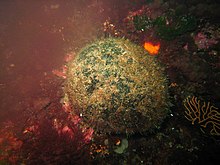Codium bursa is a green marine algae of medium size.
| Codium bursa | |
|---|---|

| |
| Codium bursa in Niolon near Marseille | |
| Scientific classification | |
| Clade: | Viridiplantae |
| Division: | Chlorophyta |
| Class: | Ulvophyceae |
| Order: | Bryopsidales |
| Family: | Codiaceae |
| Genus: | Codium |
| Species: | C. bursa
|
| Binomial name | |
| Codium bursa | |
Description
editCodium bursa is a marine alga growing to 30 cm across. It generally appears as a spongy sphere of utricles which at the surface form a cortex. It is composed of loosely packed filaments which at the surface form a cortex of utricles which are single celled bladder-like or club-shaped structures.[2] It has a velvety texture and is dark green in colour. The alga is attached by a holdfast of filaments.[3]
Distribution
editIn the Atlantic from the Canary Islands to the British Isles,[4] where they perhaps are originating further south, since C. bursa is very persistent in drift.[4] In Ireland the most recent record was in 1977 from County Donegal.[5] also recorded from other countries in Europe.[3] In the Mediterranean often found accompanying the seagrass Posidonia oceanica and commonly found beachcast amongst leaves of Posidonia oceanica.[4]
Habitat
editCodium bursa grows sublittorally attached to rock to 10 m deep in the Atlantic Ocean[3] and up to 50 meters deep in the Mediterranean Sea.[4]
See also
edit- Marimo, a round, freshwater algae
References
edit- ^ M.D.Guiry. "Codium bursa - C.Agardh 1817". Alagebase. National University of Ireland, Galway. Retrieved 5 September 2019.
- ^ Burrows, E.M. 1991. Seaweeds of the British Isles. Volume 2 Chlorophyta. Natural History Museum, LondonISBN 0-565-00981-8
- ^ a b c Bunker, F.StP.D, Brodie, J.A., Maggs, C.A. and Bunker, A.R.2017. Seaweeds of Britain and Ireland. Second edition. Wild Nature Press, Plymouth.UK.ISBN 978-0-9955673-3-7
- ^ a b c d https://www.seaweed.ie/descriptions/Codium_bursa.php. Accessed 2024-01-07
- ^ Morton, O. 1978. Some interesting records of algae from Ireland. Irish Naturalists' Journal 19: 240 - 242